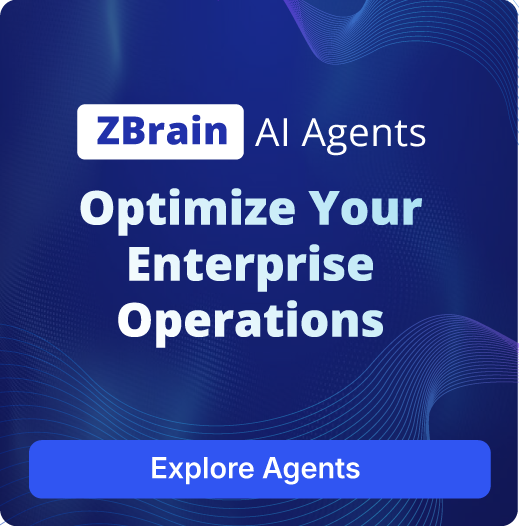Generative AI for procurement: Adoption phases, use cases, integration strategies, and future outlook

Listen to the article
The buzz around generative AI is growing louder, and for good reason. With its transformative potential, GenAI is set to transform how business functions operate, including procurement and sourcing. Procurement leaders, who are under constant pressure to enhance performance, are increasingly turning their attention to this innovative technology. According to McKinsey & Company, nearly 20% of the procurement function could be eliminated by GenAI, making it one of the most impacted business areas after software engineering and customer operations. GenAI’s ability to automate tasks like drafting and analyzing contracts, generating requests for proposals (RFPs), and handling compliance checks has sparked considerable interest.
A report suggests that by embracing and fully integrating GenAI, Chief Procurement Officers (CPOs) can eventually achieve better procurement results using only 50-75% of the resources. This prospect is incredibly appealing to procurement teams looking to reduce spending and improve stakeholder satisfaction. While the technology promises significant improvements in efficiency and effectiveness, many leaders still recognize the need to gather more information to fully understand its capabilities and potential impact on their operations.
That said, the adoption of GenAI is accelerating faster than expected. Gartner’s 2024 Hype Cycle for Procurement and Sourcing Solutions has placed GenAI at the “Peak of Inflated Expectations,” with rapid adoption across industries. In fact, Gartner predicts that GenAI will quickly move to the “Plateau of Productivity” within just two years as more procurement leaders implement use cases such as contract management and supplier collaboration. Already, 73% of procurement leaders anticipated adopting GenAI by the end of 2024, highlighting how quickly this technology is gaining traction.
As the procurement landscape continues to evolve, platforms like ZBrain are becoming essential for organizations looking to fully harness the power of generative AI. Offering a full-stack agentic AI orchestration platform, ZBrain can help businesses optimize their procurement processes, streamline workflows, and potentially unlock new efficiencies. This article explores how GenAI is reshaping procurement, the current landscape of its adoption, and how solutions like ZBrain are driving the future of smarter, more efficient procurement operations.
- What is generative AI?
- Generative AI in procurement and sourcing: An overview
- The current landscape of generative AI in procurement and sourcing
- Different approaches to integrating generative AI into procurement and sourcing
- Generative AI use cases for procurement and sourcing
- Measuring the ROI of generative AI in procurement and sourcing
- Key challenges and factors to consider when adopting generative AI in procurement and sourcing
- Essential questions and considerations when integrating generative AI into procurement processes
- Generative AI in procurement and sourcing: Future outlook
- Transforming procurement and sourcing with ZBrain: A full-stack agentic AI orchestration platform
What is generative AI?
Generative AI is a branch of artificial intelligence (AI) that creates original content in various formats, such as text, images, audio, video, or even software code, based on user prompts. Unlike traditional AI systems, which primarily analyze and interpret data, generative AI can produce new and relevant outputs by learning from existing data patterns. At the core of generative AI are deep learning models -advanced algorithms designed to mimic the neural networks of the human brain. Trained on extensive datasets, these models can identify intricate patterns and relationships within the data. Once trained, generative AI systems can generate creative outputs based on user input. For example, they can write articles, design images, compose music, or generate programming code.
Generative AI gained widespread attention with the launch of ChatGPT in 2022, marking a turning point in how businesses and individuals use AI. It quickly became a transformative tool, enabling automation of creative tasks and improving productivity across industries. Many organizations are now exploring its use for enhancing products, streamlining internal workflows, and delivering personalized customer experiences. Businesses are embracing the technology at an accelerating pace. According to McKinsey, around one-third of organizations are already using generative AI regularly, and Gartner predicts that by 2026, over 80% of organizations will have integrated generative AI applications into their operations. Generative AI represents a new era in AI-driven innovation, poised to transform industries by enabling unprecedented levels of creativity and efficiency.
Generative AI in procurement and sourcing: An overview
Generative AI is transforming procurement and sourcing by enhancing efficiency, driving innovation, and streamlining processes. This advanced technology leverages data-driven insights and automation, allowing organizations to rethink traditional procurement models and adapt to the rapidly evolving market landscape. This overview explores the profound impact of GenAI on procurement and sourcing, highlighting its benefits and key areas of transformation.
Key benefits of generative AI in procurement
- Enhanced customer experience: GenAI enables highly personalized interactions for requisitioners, department leaders, and suppliers, making processes intuitive, streamlined and tailored to specific needs.
- Increased efficiency and productivity: Automation of procurement activities frees up resources and enables self-service models, allowing professionals to concentrate on strategic initiatives rather than routine tasks.
- Greater accuracy and quality: Analyzing large datasets enables GenAI to identify patterns and insights that lead to more accurate procurement decisions, ultimately improving outcome quality.
- Greater innovation: GenAI drives innovation by offering insights into supply market trends and disruptions, speeding up sourcing and supplier onboarding while enhancing collaboration with innovative suppliers.
- Supplier performance and risk management: Data-driven insights enhance the management of supplier performance and risks, maximizing supplier relationships and mitigating potential issues.
- Connected enterprise insights: By synthesizing insights from various procurement tools and datasets, GenAI can analyze requirements, enabling proactive planning and improved alignment across departments.
Transforming the procurement function
The adoption of generative AI is set to dramatically reshape procurement’s operating model. According to KPMG’s analysis, 50–80% of current procurement work can be automated, eliminated, or transitioned to self-service models. This automation reduces costs associated with procurement processes, which currently range from 0.3% to 0.9% of revenue, and enhances the procurement function’s influence within the organization.
1. How generative AI will transform procurement
- Strategy and insights at scale: Decisions will be informed by real-time GenAI insights, which will provide strategies for all spend categories.
- High personalization: All outputs will be tailored to specific customers, suppliers, products, and services.
- Guided everything: AI agents will guide activities, enabling smart and compliant decision-making.
- Democratization of specialty work: Novice users will perform tasks that currently require extensive experience with GenAI guidance.
- Self-service feels like full service: Interactions will be proactive, intelligent, and frictionless.
- Agent vs. agent collaboration: AI agents will communicate and negotiate with customers and suppliers on behalf of their organizations.
- Current work reduction: A significant portion of source-to-pay (S2P) tasks will be automated or made more efficient.
- Shared services: Services dependent on local knowledge will become accessible through GenAI support.
Strategic priorities for procurement
In addition to transforming its own operations, procurement must also support the broader organization in adopting generative AI. This involves preparing stakeholders across various functions such as sales, customer service, IT, and HR to realize the productivity and capability improvements enabled by GenAI.
- Reevaluating and updating procurement practices:
Redefine processes and workflows to leverage GenAI capabilities effectively, ensuring a more agile and responsive procurement function. - Support generative AI adoption across the enterprise:
Facilitate the integration of GenAI across all departments, helping to manage the impacts on key contracts and spend categories while identifying new suppliers that align with innovative technologies.
Integrating generative AI into procurement and sourcing is a game-changer, enhancing efficiency while fostering innovation and strategic decision-making. By embracing GenAI, organizations can thrive in a competitive landscape, driving greater value from procurement processes and supplier relationships.
The current landscape of generative AI in procurement and sourcing
Generative AI transforms procurement and sourcing by offering innovative solutions that enhance efficiency and strategic decision-making. Traditionally, complex sourcing events like RFPs, RFIs, and RFQs require dedicated teams to manage compliance and supplier evaluations. However, the current model is hindered by resource constraints and siloed operations, leading to delays and inefficiencies.
A recent Deloitte survey reveals a significant shift toward generative AI adoption in procurement:
- 92% of Chief Procurement Officers (CPOs) plan to assess generative AI capabilities in 2024.
- Nearly 11% of organizations are investing over $1 million annually in generative AI for sourcing and procurement, with plans to double to 22% by 2025.
- Early adopters report a doubling of ROI compared to traditional methods, with some implementations exceeding 5 times ROI.
- 38% of CPOs are piloting or deploying generative AI in spend dashboards.
- 19% are focused on automating RFI/RFP/RFQ generation.
CPOs identify three primary procurement values unlocked by generative AI:
- Enhanced analytics and decision-making
- Productivity gains
- Cost optimization
Notably, the value from enhanced analytics and decision-making surpasses that from productivity gains and cost optimization combined. Furthermore, CPOs anticipate that generative AI will enable better integration with other functions, such as supply chain planning and finance, leading to a more agile and proactive procurement environment.
Different approaches to integrating generative AI into procurement and sourcing
When integrating generative AI into procurement and sourcing operations, organizations have several strategies to choose from, depending on their specific needs, available resources, and long-term goals. These approaches can be categorized into three main methods:
- Building a custom AI solution
- Deploying generative AI point solutions
- Adopting a fully integrated AI platform
Each option offers distinct advantages. Let’s dive deeper into the specific benefits of each approach.
1. Building a custom AI solution
This approach involves designing a tailored AI system from the ground up or modifying existing foundation models to cater to the unique needs of the organization.
Advantages:
- Tailored solutions: Fully aligns with the company’s specific processes and objectives, delivering more relevant, precise automation.
- Enhanced data control: Provides complete oversight over data handling, model training, and outputs, ensuring compliance with procurement regulations and internal policies.
- Process-specific optimization: Custom-built AI can optimize key areas such as supplier negotiations, contract management, and demand forecasting based on organizational priorities.
2. Using generative AI point solutions
Point solutions are standalone applications either built on top of large language models or AI features integrated into existing software to handle specific tasks.
Advantages:
- Task-specific optimization: Focuses on specific challenges providing immediate value in niche areas.
- Quick setup: Requires less time and technical expertise to implement, making it an efficient option for quick wins.
- Lower technical demands: Easier to integrate with existing systems, allowing teams to quickly adopt and benefit from AI capabilities with minimal disruption.
3. Adopting a fully integrated AI platform like ZBrain
Choosing a full-stack platform like ZBrain Builder can offer a comprehensive, end-to-end solution that consolidates all AI tools into a single interface, from data management to deployment, streamlining the entire process.
Advantages:
- End-to-end solution: ZBrain provides a unified suite of tools, managing every aspect of AI projects from data preparation to solution deployment, reducing the need for multiple, disconnected tools and enhancing operational efficiency.
- Accelerated implementation: With pre-built components, advanced orchestration, and streamlined workflows, ZBrain has the potential to shorten the time required to implement AI solutions, which could lead to faster deployment and quicker realization of benefits.
- Customizability: Highly flexible, ZBrain allows enterprises to customize GenAI solutions to suit their specific needs, optimizing workflows and aligning AI capabilities with business objectives.
- Scalability: Designed to support enterprise-level operations, ZBrain AI agents or GenAI solutions can scale as needs grow, allowing businesses to expand their AI capabilities without the need for entirely new systems.
- Robust security and compliance: ZBrain is built to meet stringent security and compliance standards, ensuring that sensitive data remains protected throughout the AI lifecycle.
- Seamless data integration: The platform simplifies the integration of both proprietary and external data, enabling the development of accurate, data-driven AI solutions that work seamlessly within complex ecosystems.
- Cost efficiency: By consolidating all AI tools into one platform, ZBrain helps reduce the need for multiple specialized resources, lowering development costs and minimizing expenses related to hiring external expertise.
Selecting the right approach for integrating generative AI into procurement and sourcing depends on the specific goals, resources, and operational complexity of your organization. Whether you opt for a fully customized AI solution, targeted point solutions, or a comprehensive platform like ZBrain, each strategy offers unique benefits that can drive innovation, improve efficiency, and enhance compliance in your procurement processes. By carefully evaluating each option, businesses can ensure their AI integration aligns with strategic objectives and delivers sustainable value.
Streamline your operational workflows with ZBrain AI agents designed to address enterprise challenges.
Generative AI use cases for procurement and sourcing
Generative AI is changing the procurement and sourcing landscape, offering innovative solutions to streamline processes, reduce manual tasks, and enhance decision-making. From automating RFP creation to optimizing supplier management, generative AI can significantly improve efficiency and drive value across the entire procurement lifecycle. Below are key use cases where generative AI is making an impact:
1. RFP creation and evaluation
- Automated RFP generation: GenAI can craft customized RFPs based on specific business needs and historical data, minimizing manual effort and ensuring consistency.
- Intelligent document processing: It analyzes supplier responses, extracting key information and identifying issues like inconsistencies or missing data.
- RFP evaluation: GenAI quickly evaluates supplier responses, identifying insights and simplifying complex information for faster decision-making.
- RFP analysis: By analyzing technical details and value propositions, GenAI generates concise executive summaries, aiding in bid comparison.
- Automated negotiations: It assists in negotiations by analyzing proposals, predicting outcomes, and generating negotiation scripts.
- Final approvals: GenAI generates comprehensive reports, picturing the evaluation process to streamline approvals.
2. Sourcing and supplier management
- Supplier discovery: GenAI analyzes external data sources to identify new suppliers based on specific criteria.
- Supplier risk assessment: It evaluates vast data sets, including financial information and public sentiment, to assess supplier risks.
- Supplier onboarding: Automates contract creation and onboarding documentation, expediting the onboarding process.
- Supplier performance management: Tracks and analyzes supplier performance, generating actionable insights for strategic decision-making.
- Supplier communication: Automates routine communications and personalizes messages to improve supplier engagement and responsiveness.
- Translation of communication: Facilitates global sourcing by translating messages across multiple languages.
3. Contract management
- Contract drafting: GenAI generates contract drafts using predefined templates, speeding up the drafting process.
- Contract review and compliance: GenAI identifies critical clauses and risks, creating summaries to accelerate the review process and ensure compliance.
- Contract performance monitoring: GenAI analyzes contract terms and performance metrics, providing insights on deviations and enabling proactive management of contract compliance and supplier performance.
4. Conversational procurement
- Chatbot interfaces: GenAI-powered chatbots provide real-time information on procurement policies and supplier data.
- Guided buying experience: Chatbots assist users in navigating the procurement process with personalized recommendations.
- Proactive alerts: Notifies users of potential supply chain risks and disruptions for better risk management.
5. Risk management and compliance
- Supplier risk assessment: Analyzes supplier data to identify risks related to financial stability, ethical practices, and geopolitical factors.
- Compliance monitoring: Automates the compliance process, keeping workflows and contracts updated with regulatory changes.
- Fraud detection: Detects potential fraud by analyzing procurement data for irregularities.
6. Strategic sourcing and category management
- Market trend analysis: GenAI identifies emerging trends, helping teams adjust sourcing strategies.
- Category strategy development: Processes historical spending and market data to generate optimized procurement strategies.
- Cost optimization: Analyzes spending data to identify savings opportunities and recommends alternative sourcing options.
7. Invoice processing and payment automation
- Automated invoice validation: Verifies invoices for accuracy and compliance, reducing errors and time spent.
- Intelligent payment routing: Optimizes payment routing by analyzing payment terms, conversion rates, and supplier preferences.
- Automated invoice processing: Matches invoices with purchase orders, extracts invoice data and generates payment instructions for faster processing.
8. Streamlined requisitioning and ordering
- Auto-generated requisitions: Automates the creation of purchase orders based on user inputs and policies.
- Requisition-to-pay assistant: Guides users through the entire procurement process, ensuring compliance and improving user experience.
- Demand predictions: Uses historical data to predict demand, optimize inventory levels and prevent stockouts.
Generative AI has significantly impacted procurement and sourcing by streamlining tasks that once required extensive manual effort. Despite the continued importance of human expertise in strategic decision-making and supplier relationship management, generative AI enhances tasks such as identifying suppliers, evaluating risks, managing contracts, and optimizing costs with remarkable speed and precision. As these technologies progress, their ability to automate and simplify complex procurement processes will expand, delivering significant benefits to organizations as they navigate the ever-changing sourcing and supplier management landscape.
Why is ZBrain crucial for modern procurement and sourcing?
ZBrain emerges as a vital generative AI solution for procurement and sourcing, where agility and data-driven decision-making are paramount. It transforms procurement operations by integrating advanced generative AI capabilities into sourcing processes, streamlining workflows, enhancing supplier relationships, and mitigating risks.
ZBrain can automate repetitive tasks such as supplier evaluations, purchase order processing, and spend analysis, allowing procurement professionals to focus on strategic initiatives that drive business value. Its powerful data analytics capabilities can expedite data processing and provide actionable insights useful for sourcing strategies, enabling teams to make informed decisions swiftly.
Security features are crucial in ZBrain, protecting sensitive supplier and financial information while ensuring compliance with industry standards. This makes it a trusted platform for managing procurement activities, where data integrity and confidentiality are essential. Additionally, ZBrain’s flexible API integration can allow seamless incorporation into existing systems, helping enhance productivity and ensuring that all procurement operations are effectively interconnected.
Furthermore, ZBrain’s adaptability can make it suitable for organizations of all sizes, allowing it to scale effortlessly as procurement needs evolve. This scalability ensures that ZBrain is not merely a short-term solution but a strategic investment for the future, poised to grow alongside the dynamic demands of the procurement landscape. Therefore, ZBrain has become more than just a tool; it has become an indispensable ally for modern procurement and sourcing, driving efficiency, enhancing security, and supporting innovation in supplier management.
Measuring the ROI of generative AI in procurement and sourcing
In procurement and sourcing, measuring the return on investment (ROI) for generative AI involves evaluating the direct financial benefits, such as cost reductions and supplier optimization, alongside operational improvements like faster sourcing cycles and enhanced risk management. ROI is calculated by comparing cost savings and process efficiencies generated through AI implementation with the investment made in the technology. This analysis typically includes quantitative metrics, such as reductions in sourcing lead times and procurement costs, and qualitative improvements, like better supplier relationships and streamlined decision-making.
ZBrain integration: Key ROI metrics for procurement and sourcing
Let’s explore specific examples from the key use-case categories we’ve discussed in procurement and sourcing:
- Supplier selection and management
Use case: Automated supplier evaluations based on performance and compliance data.
ROI metrics: Time savings in supplier assessments and improved supplier quality.
Example: ZBrain can automatically analyze supplier data, performance metrics and compliance data, reducing the time procurement teams spend on evaluations. By leveraging data-driven insights, firms can select high-performing suppliers more quickly, leading to better supply chain reliability and reduced risk, all while improving the quality of supplier relationships. - Supplier relationship management
Use case: Enhanced communication and collaboration with suppliers.
ROI metrics: Reduction in manual supplier management efforts and improved supplier response times.
Example: ZBrain can automate the communication process by generating personalized messages and updates tailored to each supplier’s unique needs and preferences. This level of customization enhances engagement and fosters stronger relationships, leading to faster responses and smoother collaboration. By minimizing manual effort and streamlining communication, procurement teams can focus on strategic initiatives, resulting in more efficient procurement processes and better partnerships. - Risk management in procurement
Use case: Proactive risk assessment and mitigation for supplier performance and supply chain disruptions.
ROI metrics: Reduced risks, minimized disruptions, and increased supply chain resilience.
Example: ZBrain can analyze historical data and market conditions to flag potential risks in the supply chain, allowing procurement teams to proactively address issues before they escalate. This reduces the likelihood of costly disruptions and improves overall supply chain stability. - Spend analysis and optimization
Use case: Automated spend analysis to identify cost-saving opportunities
ROI metrics: Reduced procurement costs and improved spend visibility
Example: ZBrain can automatically analyze spending data across categories, suppliers, and geographies, identifying areas where procurement costs can be optimized. By consolidating this data, teams gain better visibility into their spending patterns and can make more informed decisions about reducing excess costs and increasing overall savings. - Automation of purchase order (PO) processes
Use case: Automated generation, tracking, and management of purchase orders.
ROI metrics: Time savings, reduction in manual errors, faster order processing times.
Example: ZBrain can streamline the purchase order process by automating the generation and approval workflows. This helps reduce the time required to manage orders and minimize manual errors, leading to faster order fulfillment and increased operational efficiency. - Contract management and negotiation
Use case: AI-powered contract generation and negotiation.
ROI metrics: Reduced time for contract drafting and improved negotiation outcomes.
Example: ZBrain can facilitate faster contract generation and assist in negotiating better terms by analyzing historical contract data, pricing trends, and legal considerations. Procurement teams can reduce the time spent drafting contracts and gain better insights into favorable negotiation strategies, leading to more advantageous contracts and reduced legal risks.
These examples illustrate the potential benefits of integrating ZBrain into procurement and sourcing processes, such as cost reductions, efficiency improvements, and better supplier engagement. By measuring and reporting on these outcomes, organizations can effectively demonstrate the value of their generative AI investments, paving the way for further integration of AI technologies across additional operational areas. This strategic approach maximizes return on investment and fosters a culture of innovation within the organization.
Key challenges and factors to consider when adopting generative AI in procurement and sourcing
Integrating generative AI in procurement and sourcing holds significant promise for enhancing efficiency and decision-making. However, organizations face various challenges that can impede successful adoption. This table outlines the key challenges associated with adopting generative AI and how ZBrain effectively addresses each one.
| Aspect | Challenge | How ZBrain addresses them |
|---|---|---|
| Internal IT and AI capabilities | Limited in-house expertise and resources for AI development can hinder effective implementation. | ZBrain Builder’s low-code platform can empower teams with limited AI knowledge to build and deploy GenAI solutions and AI agents, facilitating development without needing extensive IT skills. |
| Data quality and availability | Poor data quality and availability can lead to ineffective AI outputs and hinder decision-making in sourcing and procurement. | ZBrain Builder can integrate diverse data formats and sources, facilitating access to high-quality data for AI applications, potentially improving the accuracy and effectiveness of procurement decisions. |
| Deployment and security | Ensuring secure deployment of AI solutions while managing sensitive procurement data poses significant challenges. | ZBrain emphasizes secure deployment practices, employing encryption and access controls, and enabling organizations to utilize proprietary data securely while complying with data privacy regulations. |
| Integration with existing systems | Difficulty in integrating AI solutions with current procurement tools and workflows can slow down processes and reduce efficiency. | ZBrain Builder offers extensive APIs and compatibility features that can facilitate seamless integration with existing procurement tools, minimizing disruptions and enabling a smoother transition to AI-enhanced processes. |
| Ethical and legal considerations | Navigating the ethical and legal implications of AI use, including data privacy and compliance, presents challenges for organizations. | ZBrain includes built-in compliance monitoring and ethical guidelines, helping organizations align their AI applications with legal requirements and ethical standards in procurement processes. |
| Change management | Resistance to change from stakeholders accustomed to traditional procurement methods can hinder AI adoption. | ZBrain can support change management through user-friendly interfaces and collaborative features, potentially enabling procurement teams to engage with AI solutions actively and easing the transition from traditional methods to advanced AI-driven processes. |
| Cost considerations | High costs associated with developing and maintaining custom AI solutions can strain procurement budgets. | ZBrain’s low-code architecture can help reduce development and maintenance costs, potentially allowing organizations to optimize their investments while leveraging the benefits of generative AI in procurement and sourcing processes without excessive financial burden. |
| Maintenance and upkeep | Ongoing maintenance and updates of AI solutions can require significant resources and expertise. | ZBrain helps simplify the upkeep of the GenAI solutions, ensuring optimal performance and reducing resource requirements for ongoing support and updates. |
Adopting generative AI in procurement and sourcing presents various challenges, from technical capabilities to ethical considerations. However, with ZBrain, organizations can effectively navigate these obstacles and unlock the full potential of GenAI in their procurement strategies. By leveraging ZBrain’s user-friendly platform, robust integration capabilities, and emphasis on security and compliance, procurement teams can drive significant improvements in efficiency and decision-making, positioning themselves for success in an increasingly competitive landscape.
Essential questions and considerations when integrating generative AI into procurement processes
As organizations increasingly recognize the transformative potential of generative AI in procurement, Chief Procurement Officers (CPOs) must approach integration thoughtfully. Properly integrating GenAI can enhance efficiency, reduce costs, and improve supplier relationships. However, it requires careful planning and consideration of various factors. Here are essential questions and considerations that CPOs should address during the integration process:
| Key questions | Considerations |
|---|---|
| What specific challenges or opportunities do we aim to address with GenAI? | Identify primary goals for implementation, such as efficiency enhancement, cost reduction, or supplier relationship improvement. |
| How will GenAI integrate with our existing procurement systems and workflows? | Assess compatibility and integration capabilities to ensure a smooth transition and maximize benefits. |
| What data is needed to effectively train and operate GenAI systems? | Ensure access to high-quality data crucial for the success of AI implementations. |
| What are the anticipated ROI, Cost vs TCO, and TVO? | Understand the total cost of ownership (TCO) and the total value of ownership (TVO) for a comprehensive financial impact view. |
| How will GenAI affect our procurement workforce? | Evaluate potential changes in workforce dynamics and skill requirements necessary for successful integration. |
| What ethical considerations and risks does GenAI entail? | Address implications, including AI biases, data privacy, and system transparency. |
| How will the success and effectiveness of GenAI in procurement be measured? | Establish clear metrics and KPIs for ongoing evaluation and alignment with business goals. |
| What is our strategy for scaling and evolving GenAI solutions? | Plan for long-term adaptation and scalability of GenAI to ensure enduring success. |
| How does GenAI influence our time to market? | Understand the impact of speed and responsiveness in market-related decisions. |
By addressing these key questions and considerations, CPOs can ensure a smoother integration while aligning with organizational goals and ethical standards. This strategic approach will facilitate a successful transition and enable organizations to fully leverage GenAI’s potential, driving innovation and competitive advantage in the marketplace.
Streamline your operational workflows with ZBrain AI agents designed to address enterprise challenges.
Generative AI in procurement and sourcing: Future outlook
As generative AI technology continues to advance, its applications in procurement and sourcing are poised to transform the industry. The future outlook for generative AI in these areas suggests a more efficient, data-driven, and strategic approach to managing supplier relationships and procurement processes. Here are some key trends and predictions for the future of generative AI in procurement and sourcing:
- Enhanced data-driven decision-making: Generative AI will enable procurement teams to make more informed decisions by utilizing vast amounts of data. With advanced analytics capabilities, GenAI can analyze historical procurement data, real-time data, market trends, and external factors to uncover insights that drive optimal supplier selection, demand forecasting, inventory management, and strategic sourcing decisions. This data-centric approach will enable organizations to proactively respond to market changes, identify opportunities, and mitigate risks.
- Integration of AI with procurement platforms: As generative AI matures, it will increasingly be integrated into existing procurement platforms, providing users with seamless access to advanced functionalities. This integration will enhance automation in areas such as contract management, supplier evaluation, and risk assessment. Procurement professionals will benefit from GenAI-generated insights directly within their workflows, enabling them to streamline processes and enhance productivity without disrupting established practices.
- Real-time risk management: As supply chains become more complex and interconnected, real-time risk management will become crucial. Generative AI can continuously monitor external factors, such as market fluctuations and geopolitical events, to identify potential risks and opportunities. This proactive approach will allow procurement teams to take timely actions, such as sourcing alternative suppliers or adjusting inventory levels, thereby safeguarding supply chain continuity and resilience.
- Personalization of procurement processes: Generative AI will facilitate the development of personalized procurement experiences by analyzing individual user preferences and behaviors. Procurement platforms will leverage GenAI to recommend suppliers, products, and contracts tailored to specific needs, enhancing user satisfaction and engagement. This shift towards personalization will enable organizations to foster stronger relationships with suppliers and optimize procurement outcomes.
- Sustainability and ethical sourcing: As sustainability becomes a critical focus for organizations, generative AI will play a vital role in promoting ethical sourcing practices. GenAI can analyze suppliers based on sustainability criteria, helping organizations identify and engage with partners that align with their environmental and social goals. This commitment to ethical sourcing will enhance brand reputation and contribute to broader corporate responsibility initiatives.
- Collaboration and connectivity: Generative AI will facilitate enhanced collaboration among procurement teams, suppliers, and other stakeholders. Through GenAI-driven platforms, organizations can improve communication and data sharing, fostering stronger partnerships and more agile supply chains.
- Continuous learning and improvement: As generative AI systems learn from new data and experiences, they will continuously improve their predictions, recommendations, insights and decision-making capabilities over time. This dynamic learning process will enhance procurement strategies, making them more adaptive to changing market conditions and organizational needs.
The integration of generative AI in procurement and sourcing is set to transform traditional practices, offering a future where data-driven decision-making, personalization, and proactive risk management are the norm. Organizations that embrace these advancements will enhance their operational efficiency and position themselves strategically to navigate the complexities of the modern procurement landscape. With the ongoing evolution of technology, generative AI holds limitless potential to drive innovation in procurement, opening doors to smarter and more sustainable sourcing strategies.
Transforming procurement and sourcing with ZBrain: A full-stack agentic AI orchestration platform
ZBrain, with its AI capabilities, helps organizations streamline procurement processes by automating supplier evaluation, risk assessment, and contract analysis. It provides a range of features designed to enhance efficiency, ensure compliance, and support data-driven decision-making.
-
AI readiness assessment: ZBrain’s AI readiness assessment framework, ZBrain XPLR, evaluates an organization’s preparedness for AI adoption in procurement. It provides actionable insights to identify strengths, gaps, and opportunities for automation, ensuring a seamless AI-driven transformation.
-
Low-code development: ZBrain’s low-code platform, ZBrain Builder, enables procurement teams to create custom AI solutions for supplier selection, contract management, and purchase order compliance without requiring extensive technical expertise.
-
Proprietary data utilization: The platform allows organizations to leverage their proprietary procurement data effectively, ensuring AI models are aligned with specific sourcing strategies, supplier performance metrics, and compliance requirements.
-
Enterprise-ready: Designed for large-scale procurement operations, ZBrain Builder offers security, scalability, and seamless integration with enterprise resource planning (ERP) and supplier management systems, optimizing procurement workflows.
-
End-to-end support: ZBrain Builder manages the entire procurement lifecycle—from supplier evaluation to contract execution and compliance monitoring—ensuring efficiency, transparency, and risk mitigation.
-
Flexible data ingestion: ZBrain integrates procurement data from multiple sources, including supplier databases, purchase orders, and compliance records, to provide real-time insights that improve supplier negotiations, cost optimization, and risk assessment.
-
Intelligent agent creation: AI agents built on ZBrain Builder can automate key procurement tasks, such as bid analysis, contract review, and fraud detection, reducing manual effort and enhancing procurement efficiency.
These capabilities position ZBrain as a powerful tool for organizations looking to optimize and automate their procurement processes, ensuring cost savings, compliance, and operational efficiency.
Endnote
The integration of generative AI into procurement and sourcing processes marks a pivotal shift in how organizations operate. As demonstrated throughout this article, GenAI offers significant opportunities for enhancing efficiency, reducing costs, and streamlining workflows. Automating routine tasks and delivering valuable insights enables procurement teams to concentrate on strategic initiatives that drive value and innovation, positioning them as vital contributors to their organizations’ overall success.
Moreover, as the landscape of generative AI continues to evolve, organizations that embrace this technology early will have a distinct advantage. The adoption of platforms like ZBrain can facilitate a smooth transition into this digital era of procurement, enabling organizations to harness the full potential of GenAI. With the right strategies in place, procurement leaders can stay aligned with industry advancements and establish new benchmarks for excellence.
As we look to the future, the call to action is clear: organizations must invest in understanding and implementing generative AI solutions in their procurement strategies. The time to act is now by exploring the capabilities of platforms like ZBrain, procurement leaders can unlock unparalleled efficiencies and drive transformative change in their operations. Now is the perfect time to embrace this technological shift; join the movement toward smarter, more effective procurement today!
Ready to elevate your procurement and sourcing processes with the power of GenAI? Leverage ZBrain for custom GenAI solutions that can drive efficiency and innovation in your organization!
Listen to the article
Table of content
- What is generative AI?
- Generative AI in procurement and sourcing: An overview
- The current landscape of generative AI in procurement and sourcing
- Different approaches to integrating generative AI into procurement and sourcing
- Generative AI use cases for procurement and sourcing
- Measuring the ROI of generative AI in procurement and sourcing
- Key challenges and factors to consider when adopting generative AI in procurement and sourcing
- Essential questions and considerations when integrating generative AI into procurement processes
- Generative AI in procurement and sourcing: Future outlook
- Transforming procurement and sourcing with ZBrain: A full-stack agentic AI orchestration platform
Frequently Asked Questions
What is ZBrain, and how can it optimize procurement operations with generative AI?
ZBrain is an end-to-end AI enablement platform that assists businesses in seamlessly integrating gen AI into various functions, including procurement. From assessing AI readiness to deploying intelligent solutions, ZBrain empowers procurement teams to enhance efficiency, improve supplier relationships, and align procurement strategies with organizational goals.
Here’s how ZBrain enhances procurement operations:
-
AI readiness assessment with ZBrain XPLR: ZBrain XPLR provides a detailed AI readiness assessment, helping procurement teams evaluate their current processes and identify areas for AI-driven optimization. This ensures a strategic approach to AI adoption, improving supplier selection, contract management, and spend analysis.
-
Seamless data ingestion and integration: ZBrain Builder integrates with Enterprise Resource Planning (ERP) systems, Supplier Relationship Management (SRM) platforms, and procurement databases to unify data from multiple sources. This enables real-time analytics, helping procurement teams make data-driven decisions on sourcing, supplier performance, and risk management.
-
Low-code development environment: ZBrain Builder’s intuitive, low-code interface allows procurement professionals to create and deploy AI-driven solutions with minimal technical expertise. This accelerates automation in key procurement processes, such as purchase order processing, invoice management, and supplier onboarding.
-
Cloud and model flexibility: ZBrain Builder supports advanced AI models like GPT-4 and LLaMA and integrates with cloud platforms like AWS, Azure, and GCP. This flexibility allows procurement teams to deploy scalable AI solutions tailored to their organization’s unique needs.
-
Enhanced compliance and governance: ZBrain’s AI-driven analytics help procurement teams ensure compliance with procurement policies, contractual obligations, and regulatory requirements. By continuously monitoring procurement data, ZBrain flags potential risks related to supplier compliance, contract terms, and ethical sourcing.
By combining powerful gen AI capabilities with seamless data integration, ZBrain enables organizations to optimize procurement strategies, improve operational efficiency, and create a more agile, future-ready procurement function.
How does ZBrain ensure the security and privacy of sensitive data in procurement processes?
ZBrain is built with a strong focus on data privacy and security, ensuring that sensitive procurement information is protected at all stages. Here’s how ZBrain safeguards sensitive data in the procurement lifecycle:
-
Private cloud deployments: ZBrain agents can be deployed in a private cloud environment, ensuring that critical procurement data, such as supplier contracts, pricing details, and purchase orders, is securely stored within the organization’s infrastructure.
-
Robust security features: ZBrain incorporates multiple layers of security to protect sensitive data, including:
-
Access controls: Granular role-based access controls ensure only authorized personnel can view or manage sensitive procurement data, such as vendor information, contract terms, and financial transactions.
-
-
Compliance and governance: ZBrain is designed to meet industry-specific regulations and standards, ISO 27001:2022 and SOC 2 Type II, ensuring that procurement data is handled in compliance with confidentiality, integrity, and accountability requirements.
This comprehensive security approach ensures that sensitive procurement data remains protected throughout its lifecycle—from supplier evaluation and contract negotiation to order fulfillment and payment processing.
Can ZBrain AI agents be integrated with existing procurement systems?
Yes, ZBrain AI agents are designed to integrate seamlessly with existing procurement systems. The platform supports various data formats and standards, ensuring smooth interoperability with legacy ERP, supplier management, and procurement platforms.
This integration allows organizations to:
-
Leverage existing infrastructure: Enhance current procurement processes without the need for a complete overhaul of legacy systems.
-
Enrich data and workflows: Connect ZBrain AI agents with existing tools to automate vendor data validation, supplier performance monitoring, and contract management workflows, improving data accessibility and efficiency.
-
Drive AI-driven insights: Utilize gen AI capabilities to optimize supplier selection, monitor procurement spend, and enhance decision-making while maintaining compatibility with existing technologies.
By enabling seamless integration, ZBrain ensures that organizations can modernize their procurement processes without disrupting existing systems, improving overall operational efficiency.
What kind of procurement agents can be built on ZBrain Builder?
ZBrain Builder enables the development of AI agents tailored to various procurement use cases. These agents support vendor onboarding, supplier performance monitoring, expense management, and purchase order optimization. ZBrain’s advanced AI capabilities help organizations automate manual tasks, ensure compliance, and provide AI-driven insights to enhance decision-making. ZBrain helps businesses deliver a more efficient and responsive procurement system by streamlining workflows and improving procurement processes. By leveraging ZBrain’s AI-driven automation and analytics, organizations can streamline procurement operations, enhance supplier relationships, and build more responsive, data-driven procurement strategies.
How does ZBrain cater to diverse procurement needs across business operations?
ZBrain’s flexibility allows it to address various procurement needs. You can create tailored AI agents to automate vendor onboarding, monitor supplier performance, manage expenses, and optimize purchase orders. Its efficient AI agents enable businesses to enhance efficiency, accuracy, and decision-making across various procurement processes in any industry.
How can we measure the ROI of ZBrain in our procurement processes?
Measuring the return on investment (ROI) of ZBrain in procurement involves evaluating key performance indicators (KPIs) related to automation, cost savings, efficiency, and supplier management. Key metrics include:
-
Cost savings: Implementing AI-driven procurement strategies can reduce costs by optimizing supplier selection, negotiating better terms, and reducing maverick spending.
-
Process efficiency: Automating routine procurement tasks, such as purchase order processing and invoice management, leads to faster cycle times and reduces manual errors, enhancing overall operational efficiency.
-
Supplier performance: Monitoring supplier performance using AI analytics helps identify and mitigate risks, ensuring timely deliveries and maintaining quality standards.
-
Compliance and risk management: AI agents can continuously monitor procurement activities for compliance with internal policies and external regulations, reducing the risk of fraud and ensuring adherence to standards.
By tracking these KPIs, organizations can quantify ZBrain’s impact on streamlining procurement processes, reducing costs, and enhancing supplier relationships, leading to better business outcomes.
How can I get started with ZBrain for my procurement processes?
To begin leveraging ZBrain to optimize your procurement processes, please contact us at hello@zbrain.ai or complete the inquiry form on our website. Our team will reach out to discuss how ZBrain can integrate with your existing procurement systems, automate key workflows, and enhance supplier management, contract compliance, and expense tracking strategies.
Insights
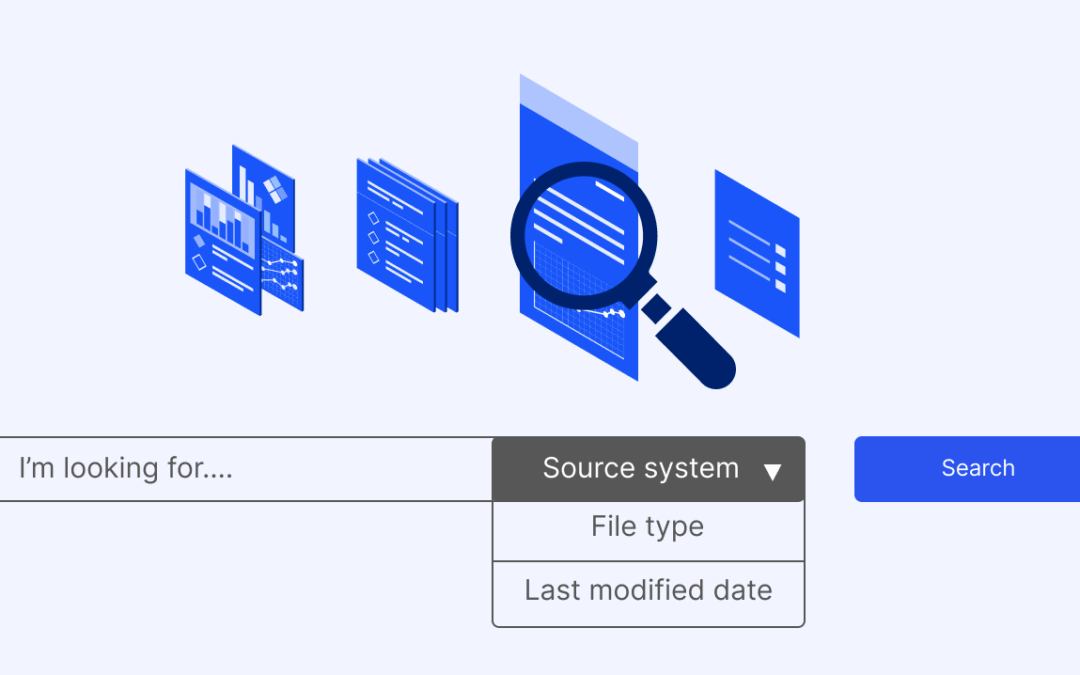
What is an enterprise search engine? A guide to AI-powered information access
An enterprise search engine is a specialized software that enables users to securely search and retrieve information from across an organization’s internal data sources and systems.

A comprehensive guide to AgentOps: Scope, core practices, key challenges, trends, and ZBrain implementation
AgentOps (agent operations) is the emerging discipline that defines how organizations build, observe and manage the lifecycle of autonomous AI agents.
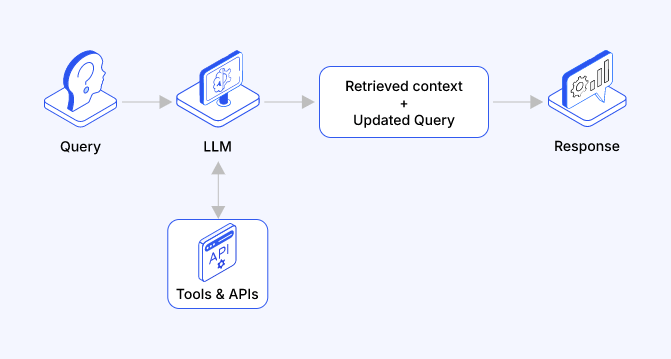
Adaptive RAG in ZBrain: Architecting intelligent, context-aware retrieval for enterprise AI
Adaptive Retrieval-Augmented Generation refers to a class of techniques and systems that dynamically decide whether or not to retrieve external information for a given query.
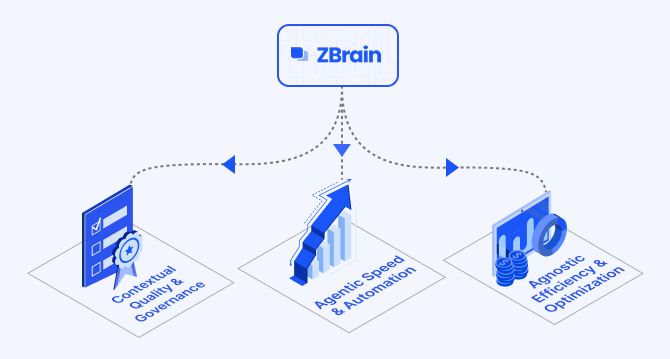
How ZBrain breaks the trade-offs in the AI iron triangle
ZBrain’s architecture directly challenges the conventional AI trade-off model—the notion that enhancing one aspect inevitably compromises another.
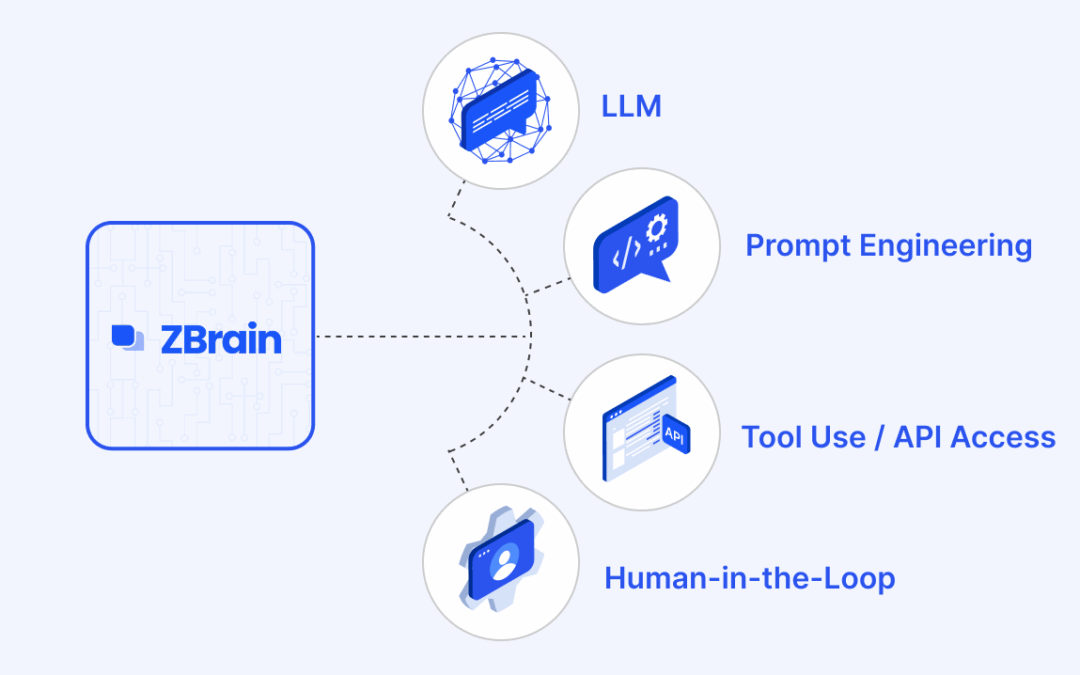
ZBrain Builder’s AI adaptive stack: Built to evolve intelligent systems with accuracy and scale
ZBrain Builder’s AI adaptive stack provides the foundation for a modular, intelligent infrastructure that empowers enterprises to evolve, integrate, and scale AI with confidence.
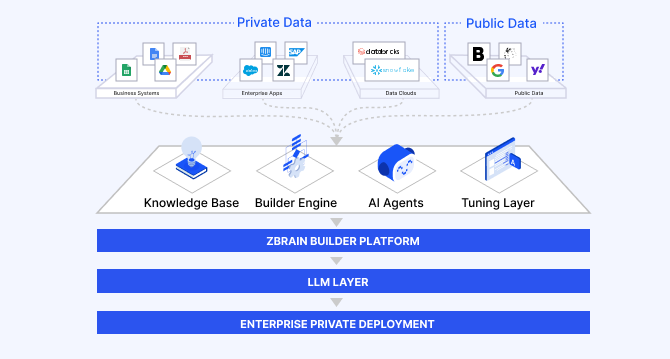
Automated AI workflows with ZBrain: Flows, LLM agents and orchestration patterns
ZBrain enables enterprises to design workflows that are intuitive for teams, efficient in execution, and adaptable to evolving business needs—transforming automation into a strategic advantage.
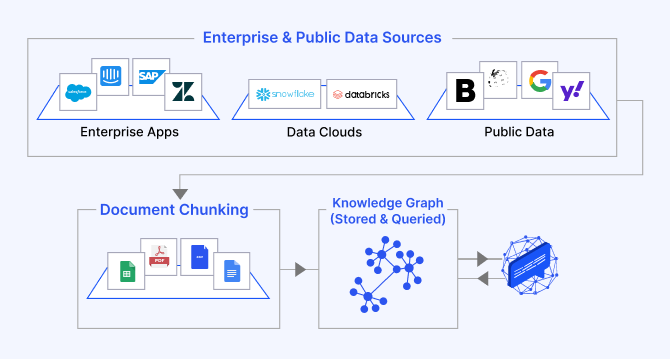
The role of knowledge graphs in building agentic AI systems: Architecture, reasoning, and ZBrain’s implementation
ZBrain Builder leverages knowledge graphs to improve contextual precision and enable reliable multi-hop reasoning in its agent responses.

ZBrain Builder: The agnostic agentic AI platform redefining enterprise AI orchestration
ZBrain Builder simplifies many aspects of AI development through its low-code interface and agnostic integration capabilities, maximizing its value depends on thoughtful planning across deployment, configuration, governance, and integration.
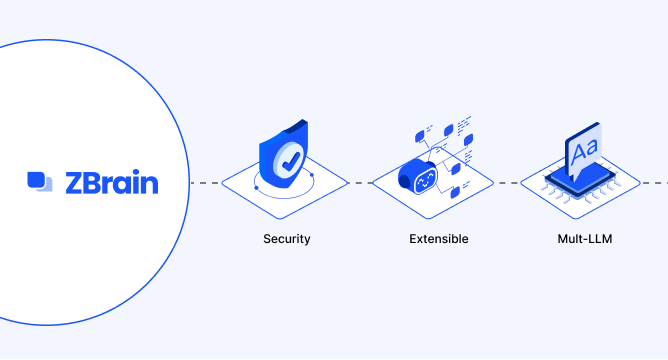
How ZBrain Builder accelerates enterprise delivery with low-code development
Low-code development and generative AI are two transformative forces that converge in ZBrain Builder to create a potent platform for enterprise innovation.




